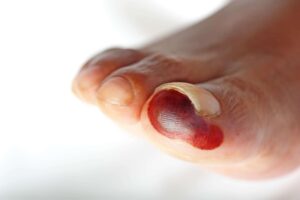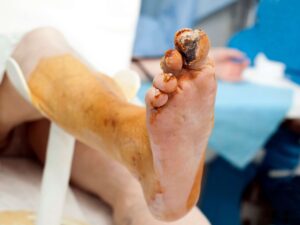Gangrene is a serious medical condition that occurs when body tissue dies because of a lack of blood supply. It can be potentially life-threatening and requires prompt medical attention. Gangrene can develop for a number of different reasons, including infections, underlying health conditions, and injuries. Being able to identify the signs of gangrene and its causes is crucial to receiving early treatment and preventing it from escalating.
What is Gangrene?
 Gangrene is where body tissue, often skin and muscles, starts to die as a result of reduced blood supply. Without sufficient blood flow, cells are deprived of oxygen and nutrients, leading to tissue death. If left untreated, gangrene can lead to serious complications, including the spread of infection and even the need for amputation.
Gangrene is where body tissue, often skin and muscles, starts to die as a result of reduced blood supply. Without sufficient blood flow, cells are deprived of oxygen and nutrients, leading to tissue death. If left untreated, gangrene can lead to serious complications, including the spread of infection and even the need for amputation.
Types of Gangrene
There are different types of gangrene, each with unique characteristics and causes. The two most common types include:
- Dry Gangrene: This type of gangrene typically occurs due to reduced blood flow and often affects the extremities like toes, fingers, and limbs. Dry gangrene usually develops slowly and is less likely to spread as quickly as other types.
- Wet Gangrene: Wet gangrene is caused by bacterial infection and is often characterized by rapid tissue decay. It is associated with a significant amount of fluid buildup, making the affected area appear swollen, discolored, and filled with pus.
There are also different types of wet gangrene such as:
- Gas Gangrene: Gas gangrene is caused by certain bacteria that release toxins and produce gas within the tissues. This leads to rapid tissue destruction and the production of gas bubbles within the affected area. Gas gangrene can be life-threatening and requires aggressive treatment.
- Internal Gangrene: This type of gangrene affects internal organs and can result from conditions like appendicitis, diverticulitis, or bowel obstruction. It can require surgical intervention to remove the affected tissue and prevent further complications.
Causes of Gangrene
Gangrene can be caused by a variety of different factors, often related to a compromised blood supply. Some common causes may include:
- Poor Blood Circulation: Conditions such as atherosclerosis, peripheral artery disease (PAD), and diabetes can lead to reduced blood flow, increasing the risk of gangrene.
- Infections: Infections can obstruct blood vessels and lead to tissue death. Bacterial infections, especially those that produce toxins, can rapidly worsen and cause gangrene.
- Injuries: Traumatic injuries, burns, and frostbite can damage blood vessels and disrupt blood flow, setting the stage for gangrene.
- Underlying Health Conditions: Conditions like diabetes, which can damage blood vessels and nerves over time, increase the risk of gangrene development.
Diabetic Gangrene
 Diabetic gangrene is a particularly concerning complication for individuals with diabetes. High blood sugar levels can damage blood vessels and nerves, reducing circulation and the body’s ability to detect injuries. This combination makes diabetic individuals more susceptible to developing gangrene, especially in the feet and lower extremities.
Diabetic gangrene is a particularly concerning complication for individuals with diabetes. High blood sugar levels can damage blood vessels and nerves, reducing circulation and the body’s ability to detect injuries. This combination makes diabetic individuals more susceptible to developing gangrene, especially in the feet and lower extremities.
Signs and Symptoms of Gangrene
The symptoms of gangrene can vary depending on the type and stage of the condition. Common signs and symptoms often include:
- Discoloration of the skin, turning it pale, blue, black, or green.
- Severe pain or a lack of sensation in the affected area.
- Foul-smelling discharge, especially in cases of wet gangrene.
- Swelling, tenderness, and a feeling of warmth around the affected area.
- Blisters, ulcers, or open sores that do not heal.
- Muscle stiffness and limited movement in the affected area.
Early Stages and Prevention
Detecting gangrene in its early stages is crucial for successful treatment. Dry gangrene might start with mild pain and a feeling of coldness in the affected area. Skin discoloration might also be present. If you notice any symptoms, it’s important to visit a wound care center or consult a specialist right away.
Prevention also plays a vital role in avoiding the development of gangrene. Here are some steps you can take to help reduce your risk:
- Manage Underlying Conditions: Keep underlying health conditions, especially diabetes, under control to minimize the risk of circulation problems. If you are suffering from diabetes, it’s important to take extra care of your feet and know how you can help prevent foot ulcers.
- Practice Good Hygiene: Proper hygiene helps prevent infections that can lead to gangrene. Clean and care for wounds promptly.
- Stay warm in cold weather to prevent frostbite from developing.
- Quit Smoking: Smoking damages blood vessels and reduces blood flow, increasing the risk of gangrene.
- Healthy Lifestyle: Adopt a healthy lifestyle that includes a balanced diet, regular exercise, and maintaining a healthy weight.
- Avoid Injury: Take precautions to avoid injuries, especially to the extremities. Properly care for wounds and burns to prevent infection.
Treatment Options For Gangrene
The treatment approach for gangrene depends on its type and severity. Prompt medical intervention is essential to prevent the condition from worsening. After an initial assessment, treatment options typically include:
- Surgical Removal: In many cases, the dead tissue needs to be surgically removed to prevent infection and further tissue damage. This procedure is known as debridement.
- Antibiotics: If the gangrene is caused by an infection, antibiotics are prescribed to eliminate the bacteria and prevent the infection from spreading.
- Hyperbaric Oxygen Therapy: This involves breathing pure oxygen in a pressurized environment, which helps improve oxygen supply to the affected tissues and aids in healing.
- Amputation: In severe cases, where the gangrene has caused irreversible damage, amputation might be necessary to save the patient’s life and prevent the infection from spreading.
Grafting
Following surgical removal of the necrotic tissue, grafting techniques are often utilized to aid in the healing process. This process typically involves transplanting healthy tissue to the wound site to facilitate healing and encourage the growth of new tissue. Grafting not only helps in wound closure but can also minimize the risk of infection and reduce scarring.
Post-Surgical Misting
After grafting or other surgical interventions, maintaining an optimal wound environment plays a crucial role in recovery. Post-surgical misting, also known as moist wound therapy, involves applying a fine mist of sterile saline solution or another specialized solution directly to the wound area. This technique helps create a moist environment that promotes cell growth, granulation tissue formation, and faster wound healing. Misting can also help prevent graft drying, a common concern after grafting procedures.
Tips to Help Stop Gangrene from Spreading
Stopping the spread of gangrene is critical to preventing complications. Here are some things you can do:
- Seek medical attention as soon as possible if you suspect gangrene.
- Follow your doctor’s recommendations for treatment, wound care, and medications.
- Keep the affected area clean and dry.
- Regularly monitor the area for any changes, such as increased pain, swelling, or discharge.
- Maintain good blood sugar control if you have conditions like diabetes.
- Avoid tight clothing or footwear that can restrict blood flow to the affected area.
Early detection and treatment are crucial for effective management of gangrene. If you suspect you might have gangrene or notice any symptoms, do not hesitate to speak to a wound care specialist to ensure the best possible outcome for your health and well-being. Let the specialized team at West Coast Wound Center help put you on the path to recovery and improve your quality of life.
